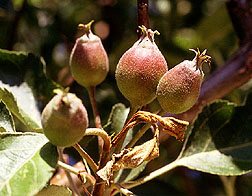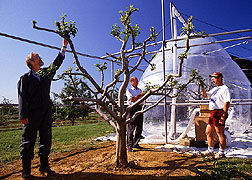Fire Blight Under Wraps
|
|
It has now been well over a century since Louis Pasteur proved that bacteria can cause disease in animals.
A few years after that well-known French scientist published his work, an American professor, T.J. Burrill of Illinois, began working with an unknown disease that was devastating apple and pear orchards in the Midwest. In 1880, he discovered that the disease now known as fire blight was also associated with a bacterium. And by 1885, Joseph Arthur performed the experiment at Cornell University that proved the suspect bacterium was truly responsible for the disease, earning him the first Doctor of Science degree granted in America.
Like Pasteur, Burrill and Arthur faced scorn and derision from distinguished scientists of their day. Eventually, a U.S. Department of Agriculture scientist named Erwin F. Smith and colleagues overcame the opposition and carried on additional research in the early 1900s that proved that bacteria cause diseases in many plants. The fire blight bacterium, Erwinia amylovora, was later named for him.
Today, yet another USDA scientist is investigating uncharted territory of this bacterial disease. Plant pathologist Tom van der Zwet has been working with fire blight at Beltsville, Maryland, and Kearneysville, West Virginia, for 30 years.
"Fire blight attacks young fruit trees—especially pear and apple—causing leaves and fruit to shrivel and blacken, as though scorched by fire," says van der Zwet. "Once it strikes, there isn't much that growers can do.
"Despite all the research that'd been done on fire blight, we still didn't know until recently if the bacterium resides in the large scaffold limbs of an infected tree's vascular system, or if it actually reinfects the tree each season," he says.
To find out, last year van der Zwet and soil scientist D. Michael Glenn, entomologist Mark Brown, and technician Craig Cavin set up an aseptic, whole-tree arborsphere—a kind of plastic growth chamber—experiment at the ARS Appalachian Fruit Research Station in Kearneysville.
"From this research, we discovered that the bacterium that causes fire blight doesn't live in a tree's older vascular system in numbers sufficient to cause disease," van der Zwet reports.
|
|
For the 6-month experiment, they used four severely blighted, 12-year-old Rome Beauty apple trees that had suffered severe fire blight nearly every year for the past 10.
In the fall of 1995, they heavily pruned the trees and removed any cankers or damaged bark that might house bacteria. Then in March 1996, they covered the trees with dormant insecticidal oil to kill any insect eggs. That treatment ensured no insects would hatch that could wound the trees' succulent new growth. Two weeks later, two of the trees were carefully hand-painted with TennCop, a copper compound, to eliminate any surface bacteria.
On April 25, 1996, van der Zwet and colleagues covered two of the trees—one copper-treated and one not—with 14- by 14-foot, clear plastic-and-pipe frames 16 feet high, creating two arborspheres. They equipped them with air supply systems and bacterial filters. This confinement was necessary because the bacteria could be carried by insects, rain, wind, or perhaps even orchard tools, to attack new growth in the spring.
On June 20th, the scientists first checked for the fire blight bacteria by lowering four open petri dishes containing a selective growth medium and sticky traps into the arborspheres. They left them there for 4 days.
"Then, twice in early July, we placed similar dishes for 2 hours on the outflow boxes where air exited the arborspheres," van der Zwet explains. "On July 23, we collected 10 shoots, free of disease symptoms, from several locations on the control trees that weren't under the arborspheres."
To check for the presence of fire blight bacteria, the plates from the arborspheres and the control shoots were incubated in the lab at 80oF.
|
|
There was no sign of bacteria on the samples taken from the arborspheres, and sticky traps caught only a couple of white apple leafhoppers.
Neither was there any evidence of fire blight from a colony of adult potato leafhoppers released into one of the arborspheres. But the control trees, not protected by the sterile atmosphere of the arborspheres, were heavily infected with fire blight.
"The unprotected trees began to show the first signs of blight on June 4, about 3 weeks after new growth emerged from the severe pruning we had done in the previous fall, but no fire blight symptoms ever appeared on the trees in the arborspheres," says van der Zwet.
The day after hurricane Fran destroyed the arborspheres on September 16, 1996, 20 shoots were collected from the protected trees and closely examined and plated in the lab for the bacteria—none were found.
"For the first time, we've shown that E. amylovora is not present as a systemic pathogen in large scaffold limbs of trees known to have been infected for the previous 10 years," says van der Zwet.
Results from the arborsphere experiment can help growers, according to van der Zwet. Extremely heavy pruning results in an overabundance of new, tender shoots that are more susceptible to fire blight infection. Therefore, when trees are dormant, growers should remove only the blighted shoots and large cankers caused by bacteria. However, proper pruning should also ensure that there is adequate light penetration into the tree canopy to maintain good tree growth.
"Our next step is to look at the presence of bacteria in younger shoot tissues, internally and externally, and to study the role of cankers in primary infection of the fire blight syndrome," van der Zwet says. — By Doris Stanley, ARS.
|
Small Cause, Big Effect Although microscopic—25,000 laid side by side or 12,000 laid end to end would not measure more than an inch—fire blight bacteria can cause big problems. One reason is that each bacterial cell is completely independent. So, under favorable conditions, cells multiply by dividing at a phenomenal rate, reaching 10 billion in 72 hours. |
Fire Blight Bulletin
Available from the U.S. Government Printing Office:
"Fire Blight—Its Nature, Prevention, and Control: A Practical Guide to Integrated Disease Management" (Agriculture Information Bulletin 631), published in 1995 by the U.S. Department of Agriculture, Agricultural Research Service. GPO Stock No. 001-000-04617-9; price $7.00 in United States, $8.75 foreign.
To order from Superintendent of Documents, phone (202) 512-1800, fax (202) 512-2250. On the World Wide Web, go to http://www.gpo.gov









